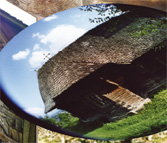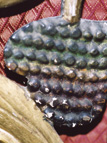The town of
Reghin is located on the river Mureşul in the foothills of the
Calimanului mountain range at a place where the Calimani hills border on
the open plains of the Transylvania region .
Reghin was incorporated as a town in 1228 A.D., as stipulated by
Augustin Theiner in his publication Vetera Monumenta Hungariae,
1859-1860, page 559. It is composed of two main populations: the ‘Saxon
Reghin’ people, living in a small subsection situated on the river, and
those living in ‘Reghin Village’ or ‘Maghiareghin’ (Hungarian-Reghin),
the much larger surrounding areas inhabited by people of Hungarian and
Romanian decent.
On the periphery of the Maghiareghin suburb there is a little wooden
church that was built in A.D. 1744. It was created in the Moldavian
style. Petru Maior, a theology student in his youth, who studied in
both Rome and Vienna and who was a member of the Uniat community of
churches, an Eastern Christian faith that accepts the authority of the
Pope but retains it’s own liturgy and discipline, served in this church
for twenty-four years, 1785-1809. He had been appointed Rector and
Archbishop of the Gurghiului region of Romania by the Ecclesiastical
Council of Solovastru, a neighborhood of Reghin, in 1785. The little
wooden church came to be known as 'Petru Maior’s Church.’
The little wooden church was built on a hill in an area where the
Romanian population of Reghin had consolidated at that time. It was
built as a Greek Orthodox Church; ecclesiastical union with Rome would
take place at a much later date in this region. Architecturally, the
plan of the church is in the shape of a cross, indicative of Moldavian
influence. The foundation is sixty centimeters wide and was made using
solid, and therefore very durable, oak wood. The upper structure is
built out of un-plastered wooden beams cut from fir trees. The complete
edifice is fifteen metres long, six metres wide, and about fourteen
metres in height. The nave of the church is spherically vaulted and it
is not known whether the vault was painted or not upon construction.
There is a four metre square polygonal altar, featuring seven faces,
erected inside the building, an extreme rarity in a wooden church.
A well-known artist, Toader Zugravul, created the original church
paintings on the altar and in the sanctuary. At the back of the
sanctuary there are fourteen little icons and Toader’s name, as well as
the date 1761, are clearly inscribed on the icon representing Saint
Nicholas. His paintings are well preserved to this day.
In 1791 Petru Maior redesigned several aspects of the building, creating
a refurbished architectural form that is still admired to this day.
There is one long roof that presents three surfaces at the altar area
and extends out over a square portico. The usual decorative archways,
found in most wooden churches, are left unembellished. The original
church did not have either a tower or a bell tower. Petru Maior added
these. He had the tower built relatively low, raising it only slightly
over roof level. On the top of the tower he had a square pyramidal shape
constructed, rather than the typical octagonal design. The tower, as a
whole, is longer than it is tall and some would say that this diminishes
the elegance and monumentality of the building but in fact the unusual
multifarious aspects of the roof and tower gives the church a very
pleasant charm. The creator and decorator of this edifice remains
unknown but judging from the high quality of the renovations and
decorating, this was indeed a master designer and carver with obvious
artistic skill.
|
-
The creations of many artists who worked in
the church have survived the centuries. There are several examples
dating from 1857. The altar is now entirely decorated with traditional
images, while the wall and the vault are splendidly painted with
depictions of religious subjects, most often saints. One can see images
of: Saint Metrophanes, Athanasius, John Crysostom, Gregory The
Theologist, Nicetas, Saint Nicholas, and Pope Sylvester. Abraham’s
sacrifice, which is a common theme in churches, is found on the front of
the altar, in the place usually designated for the un-blooded sacrifice.
On the back of the altar, over the doors, there are small pictures of
the prophets Gideon, Moses, Ezekiel, Avacum, and Samuel. Between these
doors is a painting of the Archdeacon Stefan, the first martyred deacon
of Romaine nationality. On the altar’s eastern vault one can see the
face of the Holy Blessed Virgin and, as well, the great friar hermits,
Antonius and Teofan. The height of this painting extends nearly fourteen
metres from floor to ceiling. It is a very well composed and executed
work of art from a technical point of view, in delineation and colouring
as well as composition. The painter followed the Byzantine tradition in
style and technique, a style evidenced in both Balkan and Romanian
churches of the sixteenth to eighteenth centuries. But we cannot talk
here about a ‘High-Byzantine’, ‘High-Renaissance’, or ‘High-Baroque’
style in this context because Romanian painters were local people from
the surrounding countryside who had not experienced a cosmopolitan art
training. However, the church sanctuary, as decorated in 1857, has two
majestic icons typical of the eighteenth century ‘Brancovean’ style. The
Brancovean style is especially apparent in the images of Jesus and the
Holy Blessed Virgin. On the triumphal arch there are twelve apostles
with the Holy Blessed Virgin amoung them. Representation of the
Crucifixion and of Saint John and the Angels are displayed in
rectangular frames. The small door of the altar has a sculpted top and a
multiple accolade on the wings with a painting showing the Annunciation
and the Four Evangelists. The frames of the doors and the sanctuary also
have sculpted frames, depicting the Apostles and the Primary Icons. Most
of the window arches have carved decorations. The psalm-reader’s lectern,
which is ancient, is painted with the faces of angels.
The effort and skill put into the decorations of the ‘little wooden
church’ show that the masters considered the church a perdurable
accomplishment of great value and not simply a building. Instead, Petru
Maior’s little church has become an authentication of Romania’s
aspirations and suffering throughout the centuries.
A visitor is bound to notice, even from a distance, that the Romanian
frescos in the Reghin church are a thing of great beauty and value, akin
to the magnificent carpets and rustic clothing of the region. There is
the same balance of monumental and delicate form; an image of power and
purity, almost like a silhouette or a blood-red sunset, equanimity so
much in evidence in Romania’s poetic inheritance. One can see that the
ancient painters infused the entire Romanian reality into their colours;
amiable angels are shown with grave countenances, solemn but at the same
time humorous; inhabitants of heaven hold towels in their arms that
display local ethnographical motifs, the kind you can find in any
ordinary house. And one can see also that the smoke of centuries of
unfulfilled prayers has darkened the walls of the interior of the little
wooden church and its tower.
Looking at the spire of the church one feels as if one is at the bottom
of a well whose running water sings the song of true believers. Like the
water, Petru Maior’s sermons were like a well of wisdom and as one drank
from its waters, one became purer, more exuberant, and closer to the
beatitude of bright stars. We miss Petru Maior as much as we miss the
spirit of old Dacia.
Aurel Alexe, Literature Teacher
|





